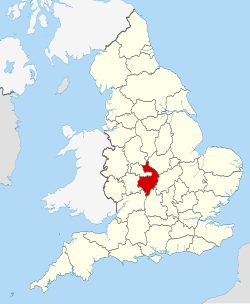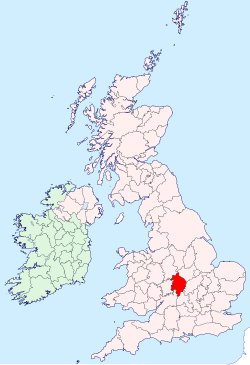Warwickshire
Warwickshire (pronounced /ˈwɒɹɪkˌʃə/, /ˈwɔːɹɪkˌʃə/, or /ˈwɔːɹɪkˌʃɪə/) is a county in central England. The county town is Warwick. The shape of the administrative area Warwickshire differs considerably from that of the historic county. Commonly used abbreviations for the county are Warks or Warwicks.
| Sovereign state | United Kingdom |
|---|---|
| Constituent country | England |
| Region | West Midlands |
| Established | Ancient |
| Time zone | UTC±00:00 (Greenwich Mean Time) |
| • Summer (DST) | UTC+01:00 (British Summer Time) |
| Members of Parliament | 6 MPs |
| Ceremonial county | |
| Lord Lieutenant | Timothy Cox |
| High Sheriff | Sophie Elizabeth Hilleary[1] (2023–24) |
| Area | 1,975 km2 (763 sq mi) |
| • Ranked | 31st of 48 |
| Population (2005 est.) | 533,900 |
| • Ranked | 39th of 48 |
| Density | 270/km2 (700/sq mi) |
| Ethnicity | 92.8% White 4.6% Asian 1.5% Mixed 0.8% Black 0.4% Other[2] |
| Non-metropolitan county | |
| County council | Warwickshire County Council |
| Executive | Conservative (council NOC) |
| Admin HQ | Warwick |
| Area | 1,975 km2 (763 sq mi) |
| • Ranked | of 26 |
| Population | 533,900 |
| • Ranked | 23rd of 26 |
| Density | 270/km2 (700/sq mi) |
| ISO 3166-2 | GB-WAR |
| GSS code | E10000031 |
| ITL | TLG13 |
| Website | warwickshire |
| Districts | |
 Districts of Warwickshire | |
| Districts | |
Warwickshire is perhaps best known for being the birthplace of William Shakespeare from Stratford-upon-Avon. The county has also produced other literary figures such as George Eliot (from near Nuneaton), Rupert Brooke (from Rugby), and Michael Drayton from Hartshill.
Geography
Warwickshire is bounded to the northwest by the West Midlands metropolitan county, and Staffordshire, by Leicestershire to the northeast, Northamptonshire to the east, Worcestershire to the west, Oxfordshire to the south, Gloucestershire to the southwest.
The majority of Warwickshire's population live in the north and centre of the county. The market towns of northern and eastern Warwickshire were industrialised in the 19th century, and include Atherstone, Bedworth, Nuneaton, and Rugby. Major industries included coal mining, textiles, engineering, and cement production, but heavy industry is in decline. Of the northern and eastern towns, only Nuneaton and Rugby (as the birthplace of Rugby football) are well known outside of Warwickshire. The rich towns of central and western Warwickshire include Leamington Spa, Stratford-upon-Avon, Kenilworth, Alcester, and Warwick. They have light to medium industries, services, and tourism as major employers.
The south of the county is largely rural and has little population, and includes a small area of the Cotswolds. The only town in the south of Warwickshire is Shipston-on-Stour. The highest point in the county, at 261 m (856 ft), is Ebrington Hill on the border with Gloucestershire, GR SP187426 at its southwest extremity.
There are no cities in Warwickshire since both Coventry and Birmingham were incorporated into the West Midlands county in 1974. The largest towns in Warwickshire as of 2004 are: Nuneaton (pop. 77,500), Rugby (62,700), Leamington Spa (45,300), and Bedworth (32,500). Stratford, Warwick, and Kenilworth all house populations with more than 20,000 inhabitants, the smaller towns of Atherstone, Alcester, Coleshill, Southam, Bulkington, Polesworth, Kingsbury, Henley-in-Arden, Studley, Shipston and Whitnash have populations between 5,000 and 12,000.
Historically much of western Warwickshire, was covered by the ancient Forest of Arden (although most of this was cut down to provide fuel for industrialisation in the 17th to 19th centuries). For this reason, the names of a number of places in the northwestern part of Warwickshire end with the phrase "-in-Arden".
Historic boundaries
Areas historically part of Warwickshire include Coventry, Solihull, and most of Birmingham. These became part of the West Midlands metropolitan county following local government re-organisation in 1974.
Since 1986 Birmingham, Coventry, and Solihull have been effective unitary authorities, but they still remain legally part of the West Midlands.
Some organisations, such as Warwickshire County Cricket Club, which is based in Edgbaston, in Birmingham, still observe the historic county boundaries.
Coventry is effectively in the centre of the Warwickshire area, and still has strong ties with the county. Coventry and Warwickshire are sometimes treated as a single area and share a single NHS trust and ambulance service as well as other institutions.
The town of Tamworth was historically divided between Warwickshire and Staffordshire, but since 1888 has been fully in Staffordshire.
In 1931, Warwickshire got the town of Shipston-on-Stour from Worcestershire and several villages, including Long Marston and Welford-on-Avon, from Gloucestershire.
Main settlements
This is a list of the main settlements in Warwickshire, including towns, or villages with a population of over 5,000. For a complete list see List of places in Warwickshire.
Places of interest

Warwickshire Media
Administrative map of the ancient county of Warwickshire in 1832. Showing Hundreds, Hundred Divisions, extant Boroughs and the County of the City of Coventry. Hundred boundaries from University of Nottingham English Place Name Society. Source data for parish boundaries - Kain, R.J.P., and Oliver, R.R. (2001) "Historic parishes of England and Wales". Unit names from Vision of Britain website.
Collegiate Church of St Mary, Warwick from Church Street
Other websites
- Warwick Chamber of Trade - An invaluable reference to the unspoilt town of Warwick
- Warwickshire County Council Archived 2019-01-02 at the Wayback Machine
Lua error in Module:Attached_KML at line 224: attempt to index field 'wikibase' (a nil value).
- ↑ "Warwickshire 2023/2024". High Sheriffs' Association of England and Wales. Retrieved 17 February 2024.
- ↑ "2011 Census: Key Statistics for local authorities in England and Wales" (XLS). Ons.gov.uk. Archived from the original on 24 February 2016. Retrieved 19 July 2017.












